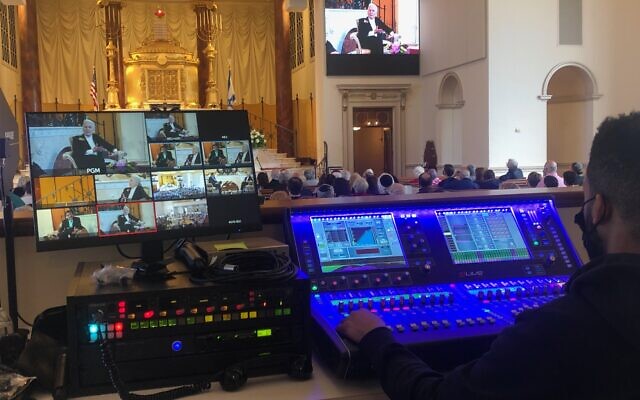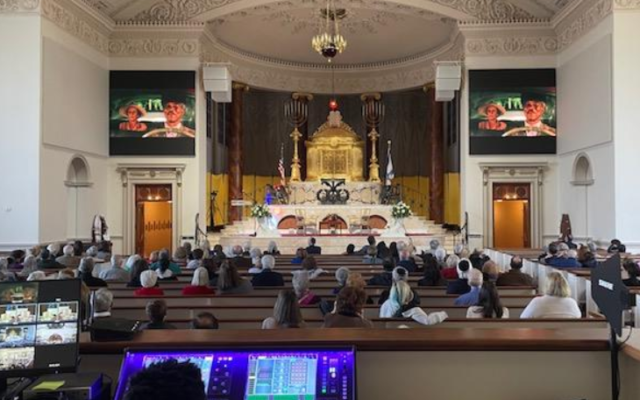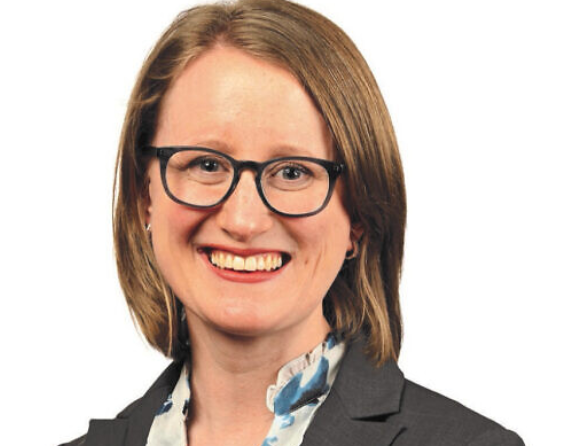The Temple Introduces Innovative Technology
Janice Rothschild Blumberg's 98th birthday celebration was an occasion for The Temple to show off its new $1.3 million technological make-over.

The Temple used the recent occasion of former Rebbetzin Janice Rothschild Blumberg’s 98th birthday celebration to unveil a new state-of-the-art video production system.
On Feb. 13 the Sunday afternoon program was described as both a historic look back and a leap forward at The Temple. They featured a screening of the 1989 Academy Award winner “Driving Miss Daisy,” which was partially filmed on the grounds and casted The Temple’s rabbi at the time, Alvin Sugarman, in a featured role.
The screening of the film was introduced, from the home of screenwriter and playwright, Alfred Uhry in New York, who received an Academy Award and a Pulitzer Prize for this script and stage play. Uhry, who is an Atlanta native and grew up at The Temple, based his production on his maternal grandmother, Lena Guthman Fox.

It follows Fox, renamed Miss Daisy, over 25 years of social and political change and prominently mentions the bombing of The Temple by white racists in 1959. Those years were roughly the same period that The Temple’s spiritual leader, Rabbi Jacob Rothschild, was married to Janice, who was interviewed at the celebration.
The Temple’s program neatly tied up 75 years of The Temple’s history with a glimpse at the historic synagogue’s technological future. The use of history, according to The Temple President Kent Alexander was no accident, “The event was a wonderful way to bridge the past and the present to the future. I just thought it encapsulated both where we’ve been and where we’re going.”
The launch of a $1.3 million amenities effectively turns the synagogue’s sanctuary into a television production center. For the program, several hundred members of the synagogue watched “Driving Miss Daisy” on a pair of large television monitors that flank each side of the bima, with its highly stylized golden ark.
Both the program before and after the screening, which featured The Temple’s senior rabbi, Peter Berg, could also be seen on the 10-foot by 10-foot monitors. Video was provided by at least four cameras during the program that were controlled by a technical director in a new platform at the rear of the sanctuary. It was designed by The Temple’s architect to complement the historic structure.
Rabbi Berg described the new set-up in what is, the oldest Jewish sanctuary in Atlanta, as the “most technologically sound, I think in North America.” It is believed that few synagogues have adapted to the latest communication advances on the scale and sophistication of this Atlanta congregation.
The planning and construction of the transformation of the building, which was originally built in 1931 and is listed in the National Register of Historic Places, began in July 2020 at one of the peak points of the COVID pandemic.
In the process of installing the new technology the entire building was rewired for audio, video and a second control room was constructed out of sight of congregants. The new construction also created a dedicated studio for the temple’s podcast that is hosted by Rabbi Berg and Rabbi Loren Lapidus, the synagogue’s senior associate rabbi.

According to Rabbi Lapidus the pandemic brought technology into the life of the synagogue as never before and accelerated the thinking of how it could be expanded in religious life, “If you think about an average Shabbat service, you see one slice of a community. But if we incorporate video and photos, if we incorporate visual tefillah, or prayer, if we incorporate creative readings, people can participate more. We have this way of continually evolving worship and it becomes very dynamic.”
As the rabbi sees it, the monitors on either side of the sanctuary can be used to incorporate new readings from sources other than the traditional siddur, or prayer book. It also allows those who might not be able to participate directly to do so from their homes as part of a Zoom or Facebook Live call that can be incorporated into the worship.
For Lapidus, the new technology provides a way to be a part of religious life as never before, even for those who may be in another city or even another country, “It also provides access. So now if you for some reason can’t travel to be at your grandchild’s b’nei mitzvah, you can still participate. You can still say the Aliyah or Torah blessing even though you are not physically in the sanctuary. We really do want to expand access and accessibility.”
For The Temple’s President, Kent Alexander, the hope is that the new technology will expose the synagogue’s programs and worship to those in the community and those more distant, who have never participated before and who may want to consider more formal affiliation.
He said, “The hope, of course, is not simply to make the synagogue experience a virtual one, but to expand the experience so you can do it in the same way as you participate in a more secular experience, like a bowl game or the symphony. You’d always much rather be there in person, but if you can’t, it’s pretty nice to have a front row seat from your home.”



comments